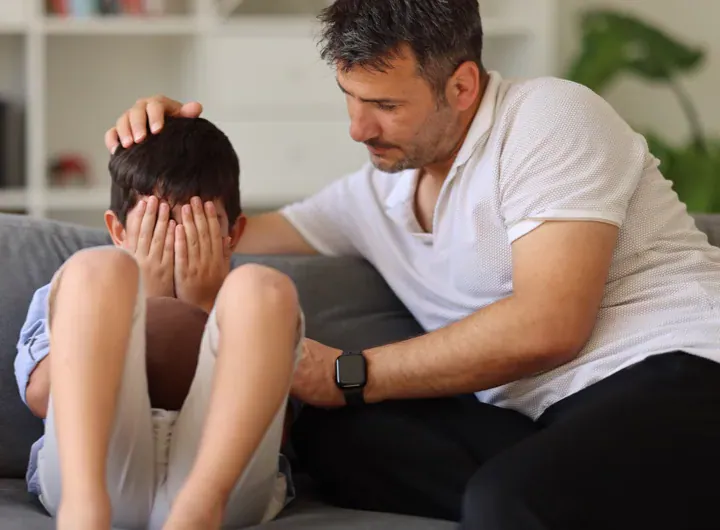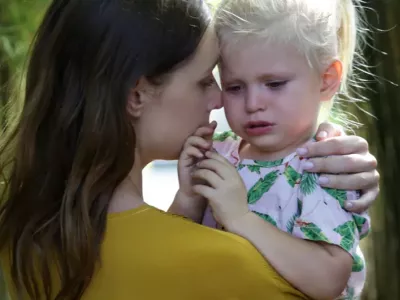Aggressive Behaviour In Children: 5 Parenting Tips

Aggressive behaviour in children can appear when they’re learning how to manage strong emotions, communicate their needs, and get along with others.
Often, children may act out aggressively as a way to express anger or frustration.
Challenging behaviour comes in all shapes and sizes. It can include hitting, kicking or biting, pulling hair, pushing, or name-calling.
While aggressive outbursts are common in children, understanding the possible causes and knowing how to deal with them can be difficult.
As a parent or carer, you may also feel a range of emotions if your child is acting out, from surprised to ashamed. That’s okay. Aggression can be difficult to deal with, but you’re not alone.
This article explores some of the common reasons why children behave aggressively.
It also provides a starting point for parents and carers to help children learn to express themselves in non-hurtful ways.
What leads to aggression in children?
Here are some common reasons:
- Frustration or anger when things don't go the way they want.
- They may hit out at others if they don’t know other ways of problem solving or managing their emotions.
- They have difficulty saying what they want or need.
- They might hit, kick, or bite to see what happens. This usually gets a big reaction from the person who is hurt and any adults present.
- They may fight out of jealousy or competition, especially with siblings.
- Sometimes, children may be aggressive to get what they want, such as making another child give up a toy or to gain attention from their parents.
- They’re overstimulated, stressed, tired or hungry.
- Children may learn to behave aggressively by watching others. If they often see other people arguing or fighting, they can be likely to do the same when they have a problem.
Sometimes, parents might have beliefs that accidentally support aggressive behaviour, such as “Kids need to let out their energy and aggression. It’s harmless”; “It's just kids being kids or Children need to learn to fight so they don't get bullied.”
When kids learn to use aggressive behaviour to get what they want, it can be tough for them to learn better ways of solving problems. If this behaviour keeps going on unchecked, it can become a pattern that's tricky to break.
How to deal with children’s aggressive behaviour: a starting point
Help them identify their feelings
Use everyday opportunities to help your child learn about emotions. Talk about feelings and acknowledge them – “You look angry. Is that because you thought it wasn't fair?”
Talk about how everyone sometimes has strong emotions like anger, fear and sadness, especially when they can't have what they want.
Let them know hard, uncomfortable feelings are normal, and it's okay to feel upset or angry, but it's not okay to shout or hurt anyone.
Suggest how they can stay calm when strong feelings happen. For example, taking some slow, deep breaths, switching to a different activity or taking a break from the situation.
Have clear, consistent rules
When everyone's feeling calm and relaxed, have a chat with your child and come up with a few simple rules for getting along with others.
Try to phrase the rules positively – make sure they say what to do rather than what not to do.
For young children such as toddlers and preschoolers, the rules could be "Speak kindly to others," "Share and take turns," and "Keep your hands and feet to yourself."
For older children, the rules could be "Be respectful," "Listen to others," and "When I’m feeling angry, take a moment to pause and breathe before reacting."
Children can get confused when they see their parents doing things they've been told not to do. So, work together with your child and try to set a positive example by following the rules yourself.
Encourage positive behaviour
Dealing with challenging behaviour can often feel like you’re constantly correcting your child or waiting for the next issue to pop up.
It’s helpful to remember children thrive on positive reinforcement. That’s why it’s important to notice and praise the behaviour you want to see more of.
When your child is being respectful, sharing, taking turns, or cooperating, it's a great opportunity to give them some attention.
The more specific your praise, the better. Specific praise helps children to understand exactly what they’re doing well, so they are more likely to repeat that behaviour again.
For example, if you notice your child sharing and taking turns with their sibling – "You’re taking turns so well with your brother! Well done, I’m proud of how nicely you’re sharing."
When no problems are happening, it's also a good chance to talk with your child about expressing their feelings in a way that doesn't hurt others.
Again, it’s best to have these conversations when things are going smoothly and everyone is feeling calm.
Set a good emotional regulation example
Kids are watching and learning how to handle strong emotions from the important adults in their lives.
We can help them learn to manage their emotions and solve problems calmly by modelling that behaviour ourselves.
For example, imagine getting home from a tough day at work. You’re still feeling grumpy, and your child wants to go to the park, but you snap at them. What could you say next?
"I'm sorry I snapped at you. I've had a really long day at work and I’m feeling frustrated, but that's no excuse for taking it out on you. Let me sit down for a few minutes with a cup of tea and take some time to calm down. Then we'll go to the park together. So why don't you finish your homework and then grab the bat and the ball? Sound fair?”
Situations like this won’t always go smoothly. However, each time a parent or carer says something like this, it helps teach their child important life-skills: recognising their emotions, owning their behaviour, apologising and making things right.
This sends a positive message that it's okay to feel strong emotions, and it's equally important to handle them properly.
It can also be helpful to have a conversation with your partner or other caregivers about how you deal with stressful moments, so you can support each other.
How to help an angry child calm down
Dealing with a child's aggressive behaviour can be a real challenge.
It's okay to feel frustrated or angry. But getting angry or yelling can escalate the situation further.
Try to make it your main focus to stay calm.
Making a conscious effort to stay calm can help deescalate the situation and set a positive example for your child.
Take a deep breath and give yourself a moment to “reset” before you respond.
This can help them feel safe and secure, knowing you can handle your emotions and theirs, even in difficult situations.
Aggression: when to worry
It is common for children to behave aggressively as they grow up and go through developmental milestones.
Research shows anger outbursts typically peak at 18 to 24 months and slowly decrease by age 5.1
In the early years, children often hit, bite, kick or scratch when they're trying to express feelings and don't yet have the words or skills to handle strong emotions calmly.
Older children and teens can become aggressive when they're struggling with emotions, challenges or changes at school, or to get what they want.
You know your child best, and if you feel like aggressive behaviour is happening too often, is too severe, or is causing harm to your child or others, it’s a good idea to seek help.
You're not alone, and there are people who can support you. Talk to your doctor or a mental health professional for advice.
References
1 Liu et al. (2013). Understanding aggressive behaviour across the lifespan. J Psychiatr Ment Health Nurs, 20(2), 156.

